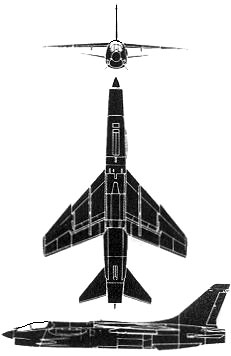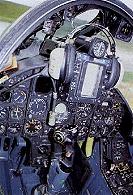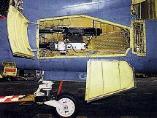

SINGLE-SEATER, SINGLE-ENGINED CARRIER BORNE FIGHTER
"If you don't know Crusaders, you're out of fighters".
HISTORY
Genesis of the program and a glorious career within the US Navy and the USMC
In 1952, 22 projects were submitted to the US Navy, which was modernizing its carrier fighter force. From all these projects, the Vought built F-8 Crusader stood out and won the competition. Three XF-8U (XF-8A) prototypes were ordered (but only 2 of them were built), and the first plane flew on March 25th 1955. It was special in that its entire wing's pitch could be modified in flight (up to +7° on US planes), allowing a proper angle of approach at low speeds, for carrier landings for example. The prototypes were powered by a 6 175 kg Pratt & Whitney J57-11 engine; later replaced by a J57-4A with 7 310kg of thrust. The first F-8As were delivered to the Navy in March 1957, and were operated by VF-32 squadron. Eventually 318 F-8As were built. The Crusader had a very impressive combat record with the Navy and Marine Corps in Vietnam, and was nicknamed "the Mig killer" because of its numerous victories over these jets. The F-8 indeed shot down 14 Mig-17s and 4 Mig-21s during the war. But all these years of combat in Asia reduced the F-8's remaining life time, and Crusader operations dropped, and finally ceased in 1969 on the east coast with the deactivation of VF-13 Fighting Thirteen and VF-62 Yellow Tails. An upgrading program was launched, and between 1967 and 1969 the F-8B, C D and E became the F-8L, K, H, while the RF-8A became the RF-8G. A new wing, an internal power unit and a new ECM suit were added. The weapon load was also increased, and the gear and hook mounts were strengthened. Two fins were retrofitted under the fuselage of the F-8Ls and Gs that didn't have them. The F-8J received a system of flaps identical to the one installed on the French version. From 1957 to 1982, the USN and the USMC flew a total of 2,360,000 hours, and 385,000 traps with the Crusader.
The RF-8G remained in service until June 30th 1982 with VFP-63. Finally, the last unit to fly the Crusader was VFP-206 Hawkeyes which retired its planes on March 29th 1987.
The different Crusader versions :
The sole French Naval Aviation'fighter for 35 years
Faced with the urgent need to retire
the venerable Aquilons, its only fleet air defence fighters, the
French Navy issued an invitation to tender. The French manufacturer
Dassault was not part of it because its navalized version of the
Mirage, still on the drawing board, had a high approach speed. The
French Navy then naturally turned towards the USA which was operating
the F-8 Crusader and the F-4 Phantom II. CC Hurel from the BET
(Technical Studies Bureau), Mr.Faucheux from the
Aeronautical Techniques Service and a engineer were rushed
across the Atlantic to decide which one of the two planes
would be the most suitable to defend the new Foch and the
Clemenceau aircraft-carriers. The Phantom II turned
out to be oversized for the small carriers, and the Crusader
was chosen. An evaluation campaign was then performed aboard
the Clemenceau on March 16th 1962 by two VF-32 F-8s
from the carrier USS Saratoga. The Ling-Temco-Vought
(LTV) manufacturer offered to build an all weather
interceptor based on the F-8U-2NE (F-8E), but with an
improoved system of flaps and the capability to fire the
MATRA R530 air to air missile. This version is dubbed
F-8E(FN). The $65 million AM-114-104 contract is for a first
batch of 40 single seaters and 6 two seaters, as well as a
large supply of spare parts and engines.
Unfortunately Congress cancelled the Twosader (two seat Crusader),
and the French Navy changed its order to 42 single seaters (BuAer
151732 to 151773). Four pilots (LV Goupil, LV de la Fournière,
EV Robillard and OE Philippe) were sent to the USA and transitioned
to the Crusader with VF-174 Hell's Razors at Cecil Field (Fl); the
first French pilot soloed May 6th 1963. The F-8U-2NE (BuAer 147036, a
transformed F-8D) prototype made its first flight on February 27th
1964. It had a entirely new wing, a special auto throttle for carrier
approaches, a stall warning, wiring for the Matra R530, a J57-P-20A
engine, and finally special test
avionics.
The third, fourth and fifth production aircrafts were committed to
weapon system tests. The carrier campaign was held in November 1964
aboard USS Shangri-La (CV-38), which is roughly the size of
Clemenceau class ships. Planes No.2 and 3 performed these
tests, flown by Dick Gralow, Goupil and James H. Flatley. Finally the
13 first aircraft were loaded on the Arromanches at Norfolk on
October 6th 1964, and arrived at St-Nazaire on November 4th. The last
29 planes were ferried on the Foch early 1965.
12.F
squadron was reactivated on October 15th 1964 with 12 airplanes. On
March 1st 1965 14.F
squadron received its planes, to replace the old Corsairs. From April
28th to May 6th 1965, 4 planes went on an evaluation cruise on the
Clemenceau. A new detachment from the CEPA , DEM 530, was
created on January 13th 1965, to adapt the Matra 530 missile onto the
Crusader. On July 6th 1965, a Crusader performed the types first
in-flight refuelling, taking on fuel from an Etendard
IVP. On September 8th both
squadrons were grouped together and formed GAN 2 (Carrier Air Wing
2). The Crusader is officially brought to active duty on March 1st
1966. 12.F squadron left its base at NAS
Lann-Bihoué and moved
to NAS
Landivisiau, followed by 14.F
squadron a few days later. 14.F squadron eventually switched to
Dassault Super-Etendards
in 1979. In October 1974 (on the Clemenceau)
and June 1977 (on the Foch),
several planes from 14.F squadron participated to the Saphir missions
(I and II) over Djibouti. On May 7th 1977, two Crusaders went
separately on patrol against supposedly French Air Force (4/11 Jura
squadron) F-100 Super Sabres stationed at the Djibouti joint forces
air base. The leader intercepted two fighters and engaged a dogfight
(supposed to be a training exercise) but quickly called his wingman
for help….he had actually engaged two Yemenite Mig-21 Fishbed
armed with four missiles each. The two French fighters switched their
master armament to "on", but in the end everyone returned to his
base. This was the only ever combat interception by a French
Crusader. On September 7th 1982, the
F-8s embarked on the Foch for mission Olifant IV, in
Lebanon. They eventually returned there for missions Olifant
XVII (September 2nd 1983) and Olifant XX (January 25th
1984). In October 1984, France sent the Foch for
operation Mirmillon off the coast of Libya, intended to calm
colonel Ghaddafi down, with 12.F squadron's famous
interceptors. The escalation of the situation in the Persian
Gulf, due to the Iran-Iraq conflict, triggered the
deployment, from July 30th onwards, of the Clemenceau
task force and its air wing composed among others of 12.F
squadron. The Prométhée mission ended on
September 16th 1988.
1993 saw the beginning of the Balbuzard missions over
ex-Yougoslavia. They were launched from both carriers cruising in the
Adriatic Sea. These missions really ceased in June 1999 with
operation Trident over Kosovo.
After it withdrew from the European study group which eventually give birth to the EF-2000 Typhoon, France decided to continue alone and launched the Rafale program. Unfortunately the Rafale M would not be available before 1996, and the French Navy had to choose between leasing American F/A-18s and thoroughly upgrading the Crusaders.
In December 1989 the French military
& industrial complex won: the Navy committed itself to the Rafale
M but also had 17 Crusaders renovated (but not modernized) at the
Cuers AIA between 1990 and 1997, with one plane rolling out every 18
months. The F-8E became the F-8P (Prolongé/Prolonged) and
received the following upgrades : -Replacement of the entire
electric circuit.
The first renovated plane (No.35) performed a tests campaign aboard
the Clemenceau in April 1993. In May 1996, the Crouze's fate
was sealed: the last airframes were to be retired no later than
December 31st 1999. By then, the F-8 was the French
Aéronautique Navale's plane that required the most maintenance
time. 1 flight hour was indeed followed by 67 hours of maintenance
(including major maintenance visits to Cuers)!

-Thorough overhaul of
the radar and of the flight
controls.
-Installation of an ILS
(Instrument Landing System).
-Installation of a Mode
4 IFF.
-New INS (Inertial
Navigation System)
-New SHERLOC
RWR.
-New Martin-Baker Mk.7
(0/0) seat instead of the old Mk.F5A-F (0/120).
From October 4th to 29th 1999, three
planes (No.11, 34, 39) were part of the Pean 99 exercise, and
operated from the Foch (R99). Other participating forces
included the European VSTOL carriers Illoustrious, Principe
de Asturias and Garibaldi.
After 140,000 hours of flight time and 25,000 traps/catapultings,
the half dozen (No.7, 10, 11, 34, 39) remaining specimen of one of
the last "Century Fighters" were retired in this end of the
millennium, on December 15th 1999 at NAS Landivisiau. Since May 18th
2001, at NAS Landivisiau in Brittany, 12.F squadron is once again
operational with its 5 Rafale M F1s. It should receive its full share
of aircraft (12 planes) by the end of 2001 or early 2002. It already
participated to the Trident d'Or exercise from May 21st to June 1st
2001 aboard the Charles
de Gaulle nuclear
carrier, along E-2C
Hawkeyes from 4.F squadron
and Super-Etendards
from 11.F and 17.F squadrons.
F-8E/P
CRUSADERs OF THE AÉRONAUTIQUE NAVALE Number Status Number Status 1 Crashed on June 12th 1987.
22 Crashed on December 8th
1977. 2 Crashed on February 4th
1989. 23 Upgraded in January
1996. 3 Upgraded in December
1993. 24 Crashed on November 24th
1970. 4 Upgraded in January 1994.
Retired in June 1997. 25 Crashed on October 26th
1981. 5 Upgraded in June 1993.
Retired on June 10th 1997. 26 Crashed on November 2nd
1971. 6 Crashed on Mars 27th 1992.
27 Upgraded in February 1994.
Crashed on March 30th 1955. 7 Upgraded in June
1994. 28 Crashed on September 29th
1965. 8 Upgraded in September
1996. 29 Upgraded in April
1994. 9 Crashed on January 28th
1977. 30 Crashed on May 9th 1985.
10 Upgraded in October
1993. 31 Upgraded in January 1993.
Crashed on July 20th 1995. 11 Upgraded in June
1994. 32 Upgraded in October
1996. 12 Crashed on June 9th 1986.
33 Crashed on May 4th 1990.
13 Crashed on February 1st
1977. 34 Upgraded in August
1993. 14 Crashed on May 9th 1985.
35 Upgraded into F-8P prototype
in 1993. 15 Crashed on April 14th 1967.
36 Crashed on October 22nd
1970. 16 Retired on April 18th 1986.
CEAN Rochefort. 37 Upgraded in January 1994.
Crashed on August 20th 1997. 17 Reformed on February 8th
1989 after a collision with an ATL-1. 38 Crashed on January 3rd 1978.
18 Crashed on October 6th 1970.
39 Upgraded in February
1997. 19 Upgraded in December 1994.
Retired in December 1997. 40 Crashed on June 18th 1983.
20 Crashed on June 13th 1983.
41 Crashed on May 14th 1980.
21 Crashed on July 24th 1968.
42 Crashed on January 14th
1988.
![]() = ejected pilot
= ejected pilot
![]() = killed
pilot
= killed
pilot
![]()
![]()
![]()
![]()
![]()
![]()
![]()
![]()
![]()
![]()
![]()
![]()
![]()
![]()
![]()
![]()
![]()
![]()
![]()
![]()
![]()
![]()
![]()
![]()
![]()
ORDNANCE -Four Colt-Browning 20mm
cannons with 125 rounds each.

-Four short range IR
Sidewinder 1A missiles. Abandoned in
1986.
-Two Matra 530
air-to-air missiles. After reliability problems (65% failure
rate in 1980), are abandoned in
1991.
-Two
short range IR Matra R550 Magic 2
missiles.
-Winch
on the starboard side of the fuselage, for DELMAR DF-14 or
HAYES TA-7 towed target. Abandoned in 1988.
AVIONICS
AND MISCELLANEOUS EQUIPMENT F-8E/P
: F-8E
: F-8P
:
-AN/APQ 104 radar
(nav:60NM / interception:
25NM).
-In flight Refuelling
probe.
-A Pratt&Whitney
J57-P-20A 5,7t engine (afterburner
8,2t).
-Martin-Baker Mk.F5A-F
(0/120) ejection seat.
-TRAP 35
antenna.
-Martin-Baker Mk.7 (0/0) ejection seat
-GPS
-VOR/ILS
-Mode 4 IFF
-VHF/UHF antennas
-TACAN
-Radio-altimeter
-ADF
-SHERLOCK RWR (Radar Warning Receiver)
![]() More
about
More
about ![]()
sources - acknowledgements
:
"Les Crusader Français en action"
Jean-Marie Gall - LELA Presse - 1997
"Histoire Succincte de
l'Aéronautique Navale (1910-1998)" Vice-Amiral Roger Vercken -
ARDHAN - 1998